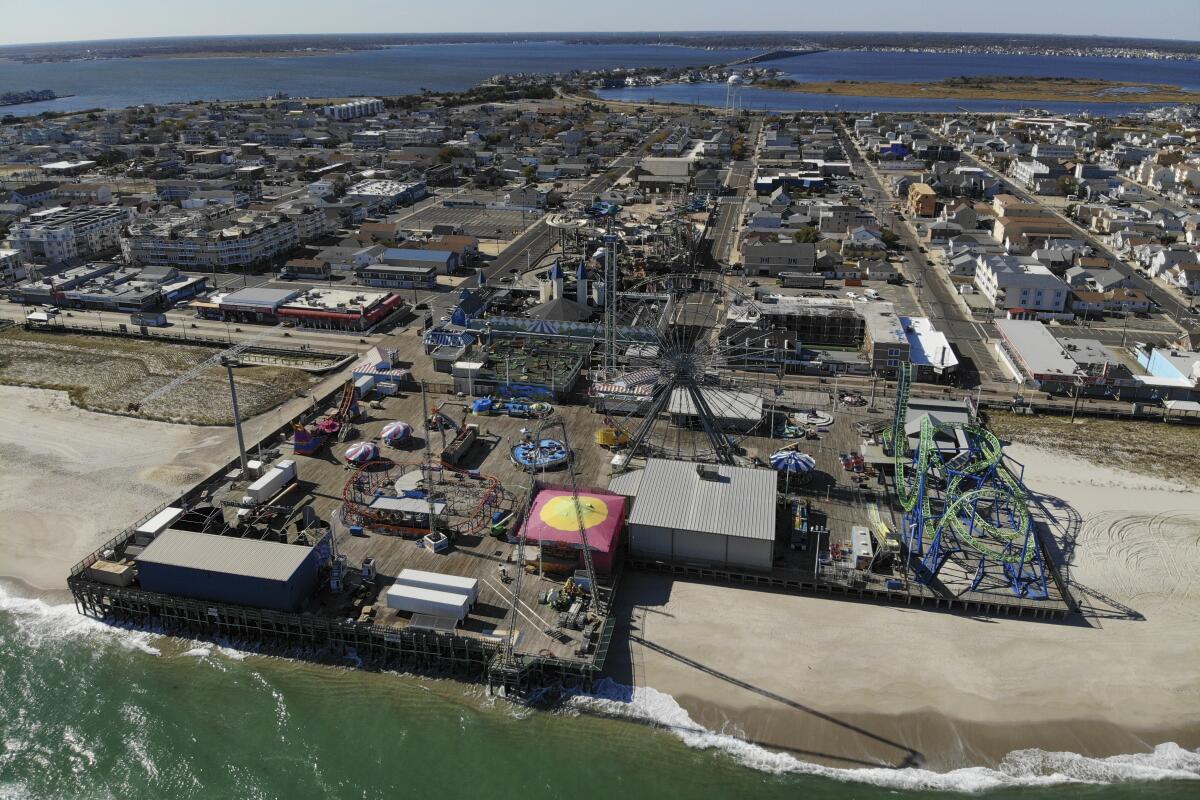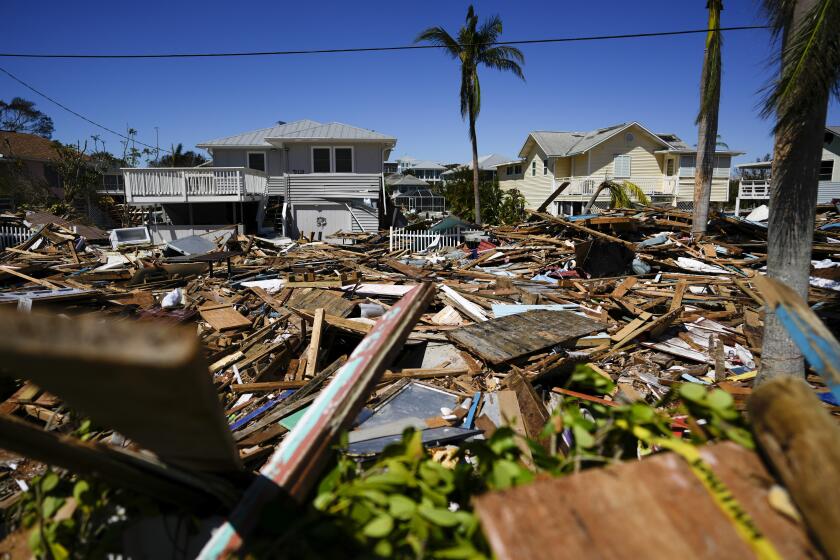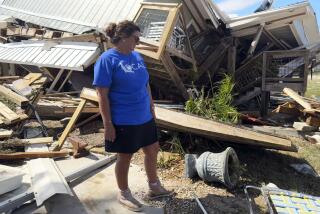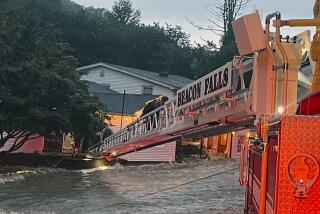Will post-Superstorm Sandy repairs be enough for the next big storm?

- Share via
HOBOKEN, N.J. — After Superstorm Sandy struck the Northeast in 2012, there was an unprecedented effort to fortify the densely populated coastline against the next big storm.
Thousands of homes were raised on pilings. Concrete and steel walls meant to help hold back the sea were hidden beneath rebuilt dunes and beach boardwalks. Tunnels near New York’s harbor were equipped with giant flood doors.
Then, last year, the region learned that even those precautions might not be enough in an age of more powerful storms.
Flash floods killed at least 58 people from Maryland to Connecticut when the remnants of Hurricane Ida blew into the Northeast after first striking the Gulf Coast. In New York and New Jersey, people drowned in basement apartments far from the ocean or a bay. In the suburbs, motorists were swept away trying to escape flooded inland roadways.
The two deadly storms, nearly a decade apart, left public officials and residents contemplating what more needs to be done. Today, 10 years after Sandy and with billions of dollars spent, the most ambitious and comprehensive protections are years away from completion, with some in early stages or even unfunded. Experts say Ida showed that the area is not ready for another storm — and they worry about what will happen when the next one hits.
“We must be more prepared than we are now,” said Shawn LaTourette, New Jersey’s environmental protection commissioner. “We have done a lot of work since Sandy: developing the dune system, the buildings raised and the flood-control infrastructure. We’re still not ready.”
Residents echo his concerns.
“I will be forever nervous because of Sandy,” said Liz Ndoye, whose Hoboken home flooded. “I will never feel safe. We can mitigate, but we will never stop the city from flooding. Every time it rains, I worry. We are in a climate crisis.”
She watched Hurricane Ian devastate the Florida coast weeks ago. “This is coming for all of us,” she said.
Billions of dollars of losses in Florida foreshadow the potential for climate-related economic destruction.
EExperts say hurricanes like Ian set off a familiar cycle: Another round of evaluations follows each storm, adding to the list of needed work, including an overhaul of aging inland storm water management systems and infrastructure projects to address climate change.
“We have to think of more sustainable ways to live along the coast,” said Greg Tolley, executive director of the Water School at Florida Gulf Coast University. “We have to do things differently. The so-called 100-year storms and the Category 4 and 5 hurricanes are happening more frequently.”
When Sandy made landfall on Oct. 29, 2012, north of Atlantic City, it touched off rethinking about not just rebuilding the region but the effects of a warming planet and rising seas.
In New York, work began last year on a $1.5-billion effort to protect Manhattan’s Lower East Side by raising the East River shoreline by about 8 feet. The project involves bulldozing 1,000 trees and a waterfront park, then rebuilding the park and a 1.2-mile-long flood wall atop tons of fill. It’s one phase of a ring of planned flood barriers and levees dubbed “The Big U.” Completion isn’t expected for years.
The project proceeded despite criticism that it cut too many mature trees. It’s a common concern among environmental advocates and others: Each project may offer a solution to a singular problem while creating new ones, especially where climate change is involved.
“Because the challenges we face are very widespread and can vary — they might deal with something like long-term sea level rise or being prepared for a big storm shock like Sandy — I think we’re at real risk of it showing up in a slightly different way, and we won’t have the defenses in place to handle that,” said Andrew Salkin, who co-founded the New York-based nonprofit Resilient Cities Catalyst. “Solely relying on hard infrastructure and gray infrastructure, like concrete and steel, to erect things to keep out nature is challenging. Over time, nature tends to win.”
Last month, the U.S. Army Corps of Engineers unveiled a $52-billion proposal to build tidal gates and storm surge barriers to protect parts of New York and northern New Jersey. Construction would start in 2030 at the earliest, with completion projected for 2044 if all is approved and funded.
The Army Corps has a separate $16-billion plan to build gates that could stop storm tides from surging up inlets and bays behind the Jersey Shore. It would be one of the costliest flood-prevention projects any state has undertaken, and there’s no guarantee Congress will pay for any of it.
Some projects launched after Sandy are complete. A 4-mile steel wall is buried under the sand of replenished beaches in Mantoloking and Brick at the Jersey Shore, where storm surge cut a coastal highway in half and swept dozens of homes into Barnegat Bay.
The Star Jet roller coaster — whose collapse into the ocean at Seaside Heights, N.J., became an iconic Sandy image — has been replaced with a new ride, built on the beach instead of over water.
A New Jersey train station where floodwater gushed in through an elevator shaft has been rebuilt with aquarium glass and flood doors that can be slammed and locked in less than a minute.
Billions of dollars have been spent hardening power infrastructure, ringing water and sewage treatment plants with better storm barriers and elevating home electrical, heating and cooling equipment.
Officials admit that the scope of that work is vast but say it’s a fraction of what is needed.
“Are we better off than we were before Sandy? No question,” said LaTourette, the New Jersey official. “But it’s not enough.”
Complicating the calculus of storm protection was Hurricane Ida — a “humongous wake-up call,” said Amy Chester, managing director of Rebuild by Design, an
organization that worked with federal officials to jump-start post-Sandy resiliency projects. “It showed us that every single community can flood, not just those in floodplains.”
The group says urban areas need to be transformed from concrete jungles into sponges by creating “resiliency parks” designed to flood during storms. The parks capture water that would otherwise flow into streets and sewer systems.
The city of Hoboken built two such parks after Sandy, with three more to come. They can hold millions of gallons of storm water, some via underground cisterns, one of which is the size of a city block.
New York has begun work to improve inland drainage, including spending $2.5 billion to upgrade antiquated sewers, though many billions more in spending would be needed to make the system capable of handling storms like Sandy or Ida.
In the Bronx, the city hopes to take a brook that was diverted into the sewer system a century ago and bring it back above ground. That might avoid a repeat of what occurred during Ida: The brook, swollen beyond capacity of the sewer pipes, ran onto a city expressway and submerged cars.
Other work that began after Sandy and continues today includes six projects sponsored by Rebuild by Design and funded in part by nearly $1 billion in federal seed money given in 2014. “The Big U” is among them; so is a resilient energy-generation project in the Bronx and a plan to lessen flooding in northern New Jersey’s Meadowlands. Other projects are in Hoboken and Bridgeport, Conn. Some aspects of the largest projects could be completed next year; others will take years more to finish.
“Am I happy with the pace? No,” Rebuild by Design’s Chester said. “But it is reality that it’s going to take time to get our cities prepared for future storms. One thing we quickly realized is just how complex these projects are.”
At a groundbreaking last month for one segment of “The Big U,” New York Mayor Eric Adams asked the federal government for an additional $8.5 billion for future storm-protection projects.
“Sandy wasn’t just a storm; it was a warning,” he said. “Another storm could hit our city at any time.”
And each storm is likely to bring more plans and adaptations.
Florida has been forced to rethink its resiliency goals, from stronger construction codes adopted after Hurricane Andrew in 1992 to a $1-billion plan, approved last year, to help communities build barriers, elevate roads, improve drainage and protect wetlands.
Tolley, the Florida educator, said Ian proved the need for urgency by all states: “We need to have that conversation now about what we have to do and what things should look like 20, 30, 40 years from now.”
In New Jersey, LaTourette agrees.
“The Sandys and the Idas will keep coming and they’ll keep getting worse,” he said.
“We have to get better at doing what we always say we’ll do: Look at things from the perspective of what we leave our kids. We decide whether the barrier islands are still there for them in their retirement,” LaTourette said. “We’re deciding that now.”
More to Read
Sign up for Essential California
The most important California stories and recommendations in your inbox every morning.
You may occasionally receive promotional content from the Los Angeles Times.











